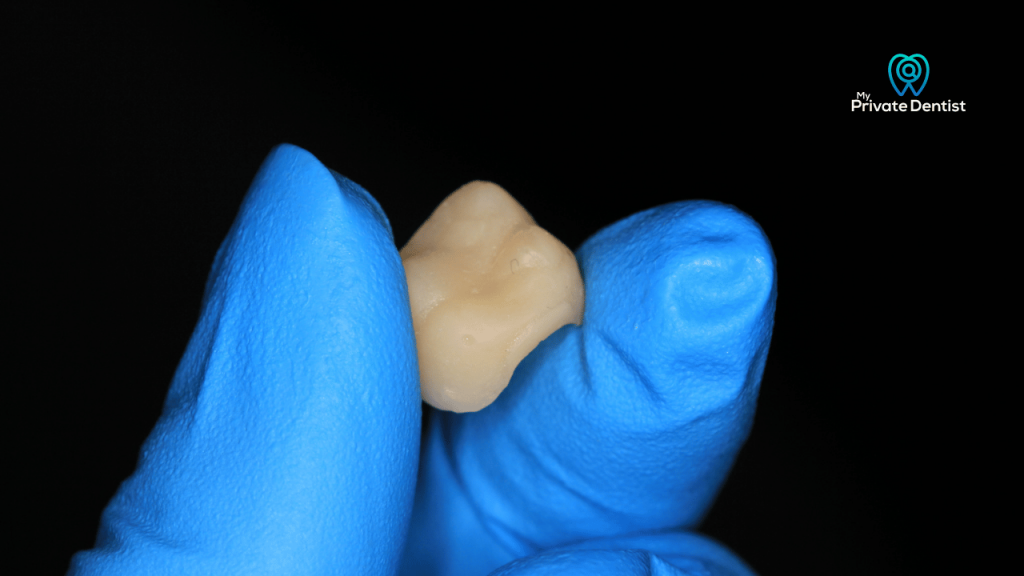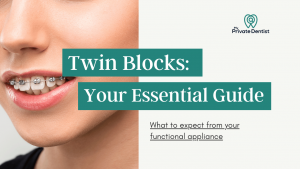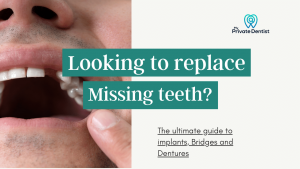So, your dentist has advised a new crown for your tooth? After the crown preparation, you will have a temporary crown fitted whilst your permanent crown is being made. A mild level of temporary crown pain is perfectly normal. You may experience some initial discomfort, especially after a long dental procedure. This should subside within a few days. If your symptoms are more severe, or do not settle, contact your dentist for advice.
As a dentist, I often place crowns to protect teeth that are at risk of breaking. A tooth would benefit from a crown if it has;
- A very large filling
- A crack ruining through it
- If it has been root canal treated
The main risks involved in having a dental crown are developing dentine sensitivity, or irritation to the dental nerve afterwards. If this happens, You may notice pain whilst you have your temporary crown, though it can take longer for symptoms to develop.
Your temporary crown is a temporary solution while we wait for the permanent crown to be made in the dental laboratory. During this time, it’s important to take good care of your temporary crown and be aware of any potential issues that may arise.
Follow the guidelines below to ensure a smooth transition from temporary to permanent crown and maintain a healthy, pain-free smile.
Table of Contents
What is a temporary crown?
After the crown preparation procedure, your dentist will fit a temporary crown as a placeholder while the permanent crown is being made. They are designed to fit snugly over the prepared tooth structure, providing protection and support for the tooth until the permanent crown is ready.
Temporary crowns are intended to be worn for a short period of time, usually two to four weeks. For this reason, they are made with materials that aren’t as strong as permanent crowns, such as acrylic or stainless steel. Temporary crowns are kept in place with weaker adhesives, so they are quick and easy to remove when it is time to place the permanent one.

Why do I have temporary crown pain?
Temporary crown pain is a common complaint among people who have recently had a crown preparation procedure. Although some discomfort should be expected, some people experience more severe symptoms. This is due to a variety of factors, including improper placement of the crown, bite issues, or infection.
What is ‘normal’ temporary crown pain?
Sensitivity: You may experience some post-op sensitivity, once the anaesthetic has worn off. This is completely normal, and in most cases will settle after a few days. Pain relief medication, such as paracetamol or ibuprofen (if suitable for you) can be helpful for the first few days.
Aching jaw or mouth: Your mouth may feel tired from being held open for a long procedure.
Sore gums: Your gums may also feel sore, and you may notice some redness, but this should also be temporary. Keeping your mouth very clean, and salt water mouth rinsing will help.
Why is my tooth still hurting after a temporary crown?
If your symptoms are not settling after 1-2 weeks, or if pain is severe, it is useful to understand what could be causing your temporary crown pain.
Sore gums
Rough edges on temporary crown: If the edges of your temporary crown are jagged/rough, they may be digging in and irritating your gums. It is easily remedied by your dentist, who can smoothe the margins of the crown away from your gums.
Not flossing around temporary crowns: Some people avoid flossing or cleaning around temporary crowns as they are worried about knocking them off. Food can trap around the margins, and cause red, sore gums that can bleed.
Pain on biting
Temporary crown is too high: If your temporary crown is too high, your teeth won’t meet together as normal when biting down. This can cause temporary crown pain, as the single tooth is being overloaded with pressure when biting force isn’t evenly distributed across your teeth. It is a simple procedure for your dentist to adjust the biting surface of temporary crown till it feels more comfortable.
Grinding your teeth: If you’re a grinder, you will be applying lots of pressure on your temporary crown. This may cause flexing in the weak temporary crown material, and it can break. People that grind their teeth, may also experience sore jaws and aching muscles. If your temp crown breaks, your dentist can make you a new one. Wearing a mouthguard can help to protect it.
Fractured tooth: A crown is often provided as a solution to a cracked tooth. If you have a crack beneath a temporary crown, it can gets wider when you apply pressure by biting. In some cases, a crack can extend to the pulp, where your nerves are. If this happens, you may need a root canal treatment before the crown is placed.
Heightened sensitivity
Temporary crown not seated properly: The temporary crown margins should fit neatly against the prepared margins of your tooth, If there are gaps or ridges between, you may experience sensitivity when eating or drinking hot or cold. This is because the tooth underlying the temporary crown isn’t sealed.
Temporary crown loose or come off: As the temporary crown is secured with a weak cement, sometimes it can come off. If this happens, the tooth may feel very sensitive. If possible, keep your temporary crown and contact your dentist to replace it.
Tooth Decay: If your temporary crown hasn’t been replaced for a long time, you are at a higher risk of developing decay at the margins. This is because a temporary crown is placed with a weak cement, and over time the seal can break down. Gaps that form can trap plaque and food, and result in painful tooth decay.
Irritation to nerve: Nerve pain can be triggered by a crown prep procedure. Often, this is transient and will settle. It is important to be aware that every time a drill is taken to remove tooth tissue, there is a risk of irreversibly damaging the nerve. Symptoms include sensitivity, throbbing or lingering pain, pressure, and tenderness but may not be specific. You may need root canal treatment if the nerve becomes irreversibly irritated.

What should I do about my temporary crown pain?
If you are experiencing temporary crown pain, there is often a simple solution. It is important to see your dentist as soon as possible, so they can assess the cause of the pain and provide appropriate treatment.
This may include adjusting the crown, prescribing medication, or recommending a different type of temporary crown material. In some cases, if the pain is severe or accompanied by other symptoms such as swelling or redness, your dentist may recommend removing the temporary crown and having root canal treatment before placing the permanent crown [1].
If you’re having temporary crown pain, you should:
Visit your dentist: they will check margins, assess bite and seal.
Keep it very clean: flossing and brushing well around your crown margins
Salt-water mouth rinsing: can help keep clean and prevent inflammation till you can get in with your dentist
Consider over-the-counter pain relief medication: paracetamol and anti-inflammatories such as ibuprofen are effective for dental pain.
How can I avoid temporary crown pain?
There are several steps you can take to avoid temporary crown pain:
Maintain good oral hygiene: Brush and floss regularly to keep your mouth clean and reduce the risk of infection. Consider using interdental brushes rather than floss, or thread floss through sideways rather than pulling up and down through the teeth.
Avoid hard or sticky foods: Foods such chewy sweets and crusty bread can put pressure on the temporary crown and cause pain
Follow your dentist’s instructions: If your dentist has given you specific instructions regarding the care of your temporary crown, be sure to follow them closely to avoid discomfort and pain.
Be patient: Temporary crowns are meant to be worn for a short period of time, and discomfort is usually temporary.
In summary
Temporary crown pain can cause some discomfort initially but doesn’t usually last longer than a few days. It is important to take good care of your temporary crown and follow the instructions provided by your dentist. If pain lingers, it may be an indication of a problem with the temporary crown, or the prepared tooth and you should visit your dentist to help.
What should I do now?
If you think you may need a crown, or want to discuss options to improve your smile, find a dentist today.



